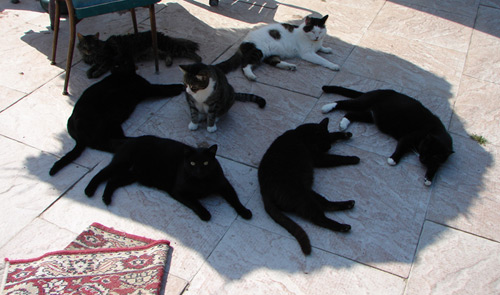The Green Revolution is an era of rapid agricultural innovation and diffusion that is critical to my own research, and I would argue, to the future of agricultural research. Narratives of the Green Revolution are invoked by different actors for different purposes; Robert Zeigler might invoke the Green Revolution as a reason to support public agricultural research. Activists like Vandana Shiva might invoke it to warn of the dangers of monocropped agriculture and top-down international development projects. I prefer to take the middle road, but the aim of my research is not to make a normative judgment about the Green Revolution. Instead, I aim to interpret how different visions of agricultural change and innovation drive organizations and technological development.
I have created a public folder of my essential Green Revolution articles, and I would also highly recommend these books by Kloppenburg, Perkins, and Cullather for an even richer perspective. There are so many things written about this topic, but I've attempted to cull it down to my favorites. I've also included my paper on the Green Revolution and the Population Bomb in Asia from 1960-1970, which I wrote for a class last year and hope to turn into a dissertation chapter. Please ask for permission if you'd like to cite or circulate my paper.
I'm going to highlight 3 papers for this post. They are articles I picked because they cover the basics of the Green Revolution, biotechnology, globalization, and some of the core STS concepts I want to explore in my research. The common theme between these 3 articles is agricultural innovation systems, and the dynamic between technologies and institutions/organizations.
Let’s start with Parayil’s 2003 paper on technological
trajectories from the Green Revolution to the “Gene Revolution” (biotechnology and molecular techniques for plant breeding).
Parayil borrows the concept of technological trajectories from a paper by
Giovanni Dosi in 1982. The unique contribution
of Dosi’s theory is that technological development occurs in a specific
technological paradigm that both produces innovations, but also constrains
these innovations to a specific trajectory. The physical properties of the
technology and its path of development, the institutional environment that
produce technologies, and the economic forces driving innovation all contribute
to a specific technological trajectory.
Parayil uses this theoretical framework
to explain how the research organizations, technologies, and economic
incentives during the Green Revolution are very different than today’s Gene
Revolution. Other factors, like globalization, neoliberalism, and intellectual
property rights also characterize today’s innovation environment. To Parayil, it
is wrong and possibly dangerous to imagine the Gene Revolution as a
continuation of the Green Revolution. I am proposing to empirically study an
actual innovation system, using the case study of northwest India. What actors
are involved in research, seed sales, and extension? To what extent are farmers
included in participatory research, and does this feed back into the system?
How do conceptions of biotechnology and the Green Revolution shape future
imaginations of agricultural adaptation to climate change?
Onto the next article, Brooks (2011) on international
agricultural research and global public goods (GPGs). Brooks discussed how the
CGIAR (an international consortium of public agricultural research centers,
several of which were critically involved in the Green Revolution) markets
itself as a purveyor of GPGs and that the “CGIAR centres would now play a
‘brokering’ role in global, heterogeneous networks comprising a wide range of
public and private institutions (Rijsberman 2002, 3). The implication was that
‘the CGIAR was uniquely placed to act as honest broker’ and steer these complex
networks in directions consistent with a public goods research mandate (Brooks
2010, 4)” (Brooks, 2011, 70). Brooks frames her argument against a 2008 paper
by Dana Dalrymple, an economist at the USDA who has promoted public
international agricultural research since the Green Revolution.
She uses the
case studies of Golden Rice, iron biofortification, and the CGIAR’s HarvestPlus
program to show how despite the CGIAR’s claims of knowledge brokering and new
research paradigms, and despite ostensibly new research partnerships and
institutional innovations, the CGIAR has maintained both institutional
dominance (in a top-down paradigm) and technological and economic reductionism
(assuming scale-neutral technologies, and silver bullet solutions to complex
social problems). My research on climate change adaptation and agricultural
research aims to uncover similar dynamics. How do international, national, and
local agricultural research organizations (including public, private, and NGOs)
use climate change as a leverage point for power? Have research paradigms
actually changed because of climate change, or are the same technological and
institutional goals maintained?
Finally, Busch and Juska (1997) discuss political economy,
actor network theory, and globalized food and agricultural systems. The authors frame their article against political economy approaches,
which focus on social power. They claim that this approach generalizes and
simplifies the range of actors involved, and demands that non-human actors
(such as food and nature) are passive. Instead, they recommend embracing actor
network theory, which seeks to remedy these oversights. They use the case
study of Canadian rapeseed (canola) to show the relationships between
scientific institutions (particularly plant breeding and organic chemistry),
technologies, and nature that were necessary to make rapeseed oil edible for
humans. Furthermore, the liberalization of global rapeseed markets led to
shifts in production and consumption. I find the actor network theory approach to agricultural
systems extremely helpful in empirically conceptualizing the connections
between scientific research, commodity chains, and producers and consumers. In
my own research, I plan on conducting a network analysis of rice and wheat
research in northwest India. I’m not as interested in the global commodity
chain, but rather the interaction between local, national, and international
actors.



